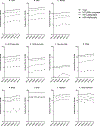Incidence of hepatocellular carcinoma among older Americans attributable to hepatitis C and hepatitis B: 2001 through 2013
- PMID: 30980394
- PMCID: PMC6625871
- DOI: 10.1002/cncr.32129
Incidence of hepatocellular carcinoma among older Americans attributable to hepatitis C and hepatitis B: 2001 through 2013
Erratum in
-
Erratum to "Incidence of hepatocellular carcinoma among older Americans attributable to hepatitis C and hepatitis B: 2001 through 2013".Cancer. 2023 Oct 1;129(19):3076-3078. doi: 10.1002/cncr.34961. Epub 2023 Aug 1. Cancer. 2023. PMID: 37526430 No abstract available.
Abstract
Background: In the United States, incidence and mortality rates of hepatocellular carcinoma (HCC) are increasing in older individuals. Chronic infection with hepatitis C virus (HCV) and hepatitis B virus (HBV) are important causes of HCC; however, the contribution of viral hepatitis to recent trends in HCC incidence among older Americans is unclear.
Methods: Data from the Surveillance, Epidemiology, and End Results-Medicare linkage (SEER-Medicare) for the years 2001 through 2013 were used to identify HCC cases among individuals aged ≥66 years and Medicare files were used to assess the HCV and HBV status of these HCC cases. Age-standardized incidence rates of HCV-attributable, HBV-attributable, and HCV/HBV-unrelated HCC were estimated overall and by age group, sex, and race/ethnicity. The authors also calculated annual percent changes (APCs) in HCC incidence.
Results: Between 2001 and 2013, a total of 15,300 HCC cases occurred in this population. Overall HCC rates increased 43% from 16.3 to 23.3 per 100,000 population (APC, 3.40% per year), whereas HCV-attributable HCC rates nearly doubled from 4.2 to 8.2 per 100,000 population (APC, 5.62% per year). HCC rates increased more slowly for HBV-attributable HCC (1.3 to 1.8 per 100,000 population; APC, 3.17% per year) and HCV/HBV-unrelated HCC (11.3 to 14.1 per 100,000 population; APC, 2.35% per year). The percentage of HCC cases with evidence of HCV infection increased from 25.7% in 2001 through 2004 to 32.3% in 2011 through 2013, whereas the percentage with HBV remained stable at 8%. In 2013, higher rates for both HCV-attributable and HBV-attributable HCC were noted among individuals aged 66 to 75 years, men, and individuals of Asian ancestry.
Conclusions: Among Americans aged ≥66 years, HCC rates increased rapidly between 2001 and 2013. Although HCV-attributable cases contributed substantially to this increase, rates of HBV-attributable and HCV/HBV-unrelated HCC also rose during this period.
Keywords: Medicare; epidemiology; hepatitis; liver cancer; trends.
© 2019 American Cancer Society.
Conflict of interest statement
The authors have no conflicts of interest to declare.
Figures


References
Publication types
MeSH terms
Grants and funding
LinkOut - more resources
Full Text Sources
Medical
Miscellaneous

